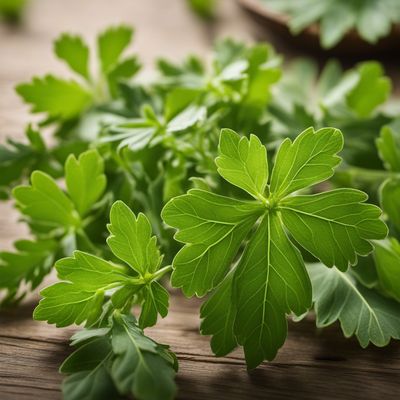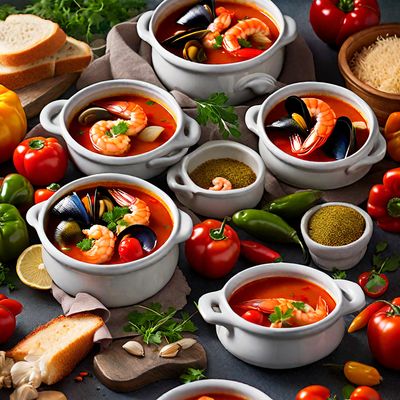
Ingredient
Bay leaves, dry
Aromatic Leaf of Flavor
Bay leaves are dried leaves from the bay laurel tree and are known for their distinctive aroma and flavor. They are commonly used in soups, stews, and various slow-cooked dishes to add depth and complexity.
Origins and history
Bay leaves have a long history and were highly regarded by ancient Greeks and Romans. They were believed to have protective properties and were used in various rituals. Today, they are cultivated in many countries and are an essential ingredient in Mediterranean and Indian cuisines.
Nutritional information
Bay leaves are not consumed in large quantities, so their nutritional value is minimal. However, they do contain vitamins A and C, as well as minerals like calcium and iron.
Allergens
There are no known allergens associated with bay leaves.
How to select
When selecting bay leaves, look for whole leaves that are intact and free from any signs of mold or damage. The leaves should have a deep green color and a strong aroma. Avoid leaves that are pale or brittle.
Storage recommendations
To preserve the flavor of bay leaves, store them in an airtight container in a cool, dark place. Avoid exposing them to heat or moisture, as this can diminish their potency.
How to produce
Bay laurel trees can be grown in containers or in the ground, but they require a Mediterranean-like climate to thrive. They prefer well-drained soil and full sun. It is best to purchase dried bay leaves from reputable sources rather than attempting to grow the tree for personal use.
Preparation tips
Bay leaves are typically used whole and are added to dishes during cooking. They are often used in stocks, soups, and braised meats to infuse a subtle herbal flavor. Remember to remove the bay leaves before serving, as they can be tough and unpleasant to eat.
Culinary uses
Bay leaves are commonly used in Mediterranean, Indian, and Caribbean cuisines. They are a key ingredient in dishes like bouillabaisse, biryani, and jerk chicken.
Availability
Bay leaves are cultivated in countries such as Turkey, Morocco, and India.
More ingredients from this category » Browse all

Lavender, dry
The Fragrant Herb: Lavender

Hyssop, dry
The Aromatic Herb: Unveiling the Secrets of Dry Hyssop

Woodruff, dry
The Fragrant Herb: Unveiling the Secrets of Dry Woodruff

Marjoram, dry
Discovering the Aromatic Delights of Dry Marjoram

Tansy and related species, dry
The Golden Herb of Ancient Times

Rosemary, dry
"The Fragrant Herb: Unveiling the Secrets of Dried Rosemary"

Wormwoods, dry
The Bitter Herb: Wormwoods

Thyme, dry
The Essence of Thyme: A Versatile Herb

Mints, dry
The Versatile Herb: Unlocking the Aromatic Power of Dry Mints

Basil, dry
The Fragrant Herb: Dried Basil

Balm leaves, dry
The Soothing Herb: Balm Leaves

Lovage, dry
The Aromatic Herb: Lovage
Recipes using Bay leaves, dry » Browse all

Bosnian-style Bouillabaisse
Sarajevo Seafood Delight

Spanish Gulyás
Gazpacho de Carne: Spanish Gulyás Twist

Sopa de Pollo y Fideos Adapted to Nouvelle Cuisine
Elevated Chicken Noodle Soup: A Nouvelle Cuisine Twist

Cuban Bouillabaisse
Sabor Cubano: A Cuban Twist on Bouillabaisse

Brazilian Bouillabaisse
Tropical Seafood Stew: A Brazilian Twist on Bouillabaisse

Soulful Chicken Soup
Soul-Warming Chicken Soup: A Hearty Delight for the Soul

Moroccan-style Feijoada
Exotic Moroccan Feijoada: A Fusion of Brazilian and Moroccan Flavors

Bavarian Chicken Noodle Soup
Hearty Bavarian Chicken Noodle Delight

Latvian-style Hot Pot
Sizzling Latvian Delight: Hearty Hot Pot

Sopa de Frango e Macarrão
Brazilian Chicken Noodle Soup

Japanese-style Gumbo
Umami-packed Gumbo with a Japanese Twist

Occitan-style Grilled Prawns with Aioli
Grilled Delicacy from the Occitan Coast: Succulent Prawns with Creamy Aioli